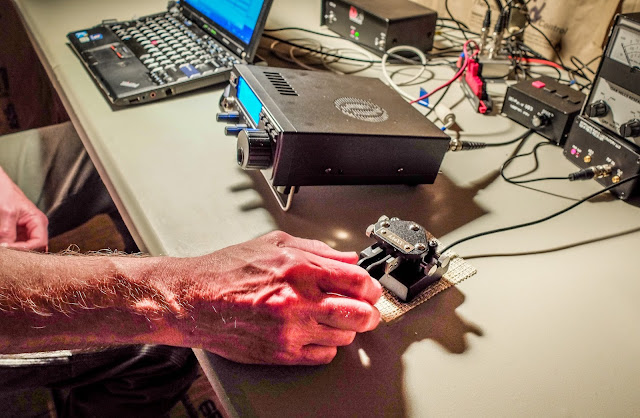Posts Tagged ‘Top Band’
 A visit with a QRP contest station
A visit with a QRP contest station
160m Spring Stew Perry Contest - QRP style
I had the opportunity to visit with Paul Stroud AA4XX as he worked the early hours in the 160m Spring Stew Perry Contest. Paul is an avid CW operator dedicated to QRP and QRPp operations. When he works contests he often participates using the Knightlites club call WQ4RP (Note the QRP in the call). |
| AA4XX operating as WQ4RP during the 160m Stew Perry Spring Top Band contest |
160m Top Band
160m (top band) is challenging due to the physical logistics of a suitable antenna. I had the opportunity to assist with a portion of raising the 160m vertical loop antenna at the "Excalibur antenna site" and installing the 24 elevated radials that help make this antenna so effective. There's a lot of wire in the ground system. The antenna site is located in the woods, off grid, and away from electrically noisy homes.Power to the remote shack is supplied by a quiet Honda 1kW generator operating a couple dozen feet from the shack. Due to the lower power requirements of QRP Paul can run the generator on eco-mode allowing its small fuel tank to provide 8 hours of operation between fill-ups.
Paul uses a Ten Tec Argonaut VI, running 5 watts output into the Excalibur 160m vertical loop. He uses N1MM+ logger software and a WinKeyer interfaced to the software. He also employs a SDR (software defined radio) feeding CWSkimmer signals across the band. An antenna splitter simultaneously feeds the SDR and the Argonaut. The SDR receiver is switched out during transmit by a DX Engineering RTR-1A Receive switch. His CW key is a N3ZN ZN-QRP model.
The N1MM+ logging software keeps track of which stations have already been worked and the CWSkimmer interface displays calling stations on the band being heard by his antenna.
 |
| The remote QRP station setup for contesting |
In the Stew Perry contest the only information exchanged was grid squares. I'm still relatively new to CW and watching Paul casually copy grid squares sent at 30wpm was impressive. I would have had to ask the caller to re-send their grid squares 5 times but Paul makes it look easy.
Instructions for the newbie
 |
| Paul demonstrating the contesting software and usage |
Why QRP?
 |
| Finding the next station to work. (N3ZN QRP CW key in the foreground) |
Why contest?
What's next?
 160 Meter fun
160 Meter fun
Instead of chasing 80 Meter Foxes, I decided to make an effort in the NAQCC 160 Meter Sprint that was held tonight. Boy, am I glad I did!
Up until now, I really haven’t had anything that loaded up well on 160 Meters. When I had my G5RV, it would load on 160 Meters; but barely and you could sure tell the radio wasn’t happy about it.
The 88′ EDZ is about the same. It will load up on 160 Meters; but the autotuner in the K3 takes a painfully long time to achieve a match. And then, if you decide to change frequency – even just a hair, the autotuner begs to be re-tuned.
The W3EDP, however? I hit the autotune button and within what seems to be about a second and a half, I get a tiny little “BRRRRP” and a 1.1:1 match. And I can tune around quite a bit without the radio complaining. I know it’s not the ideal solution for 160 Meters; but it has allowed me to make more 160 Meter contacts in one night than I have in all my 34 years of operating combined. Seriously, before tonight, I think my total QSO count on 160 Meters was maybe 3 …. 4 – maybe 5 at most?
I made 17 contacts tonight, my best DX being North Carolina, Illinois, Indiana and Ontario. Not bad for 5 Watts to a compromise antenna, eh? OK, so the W3EDP won’t earn me WAS or DXCC on 160 Meters, but at least now I have another band I can go to when other bands seem dead.
And my good friend Charles W2SH sent me an e-mail the other day, informing me about a book soon to come out from the ARRL on 160 Meter antennas, specifically for those of us who are real estate challenged. That is a must buy for me once the NJ Hamfest season starts back up again in March.
73 de Larry W2LJ
QRP – When you care to send the very least!












